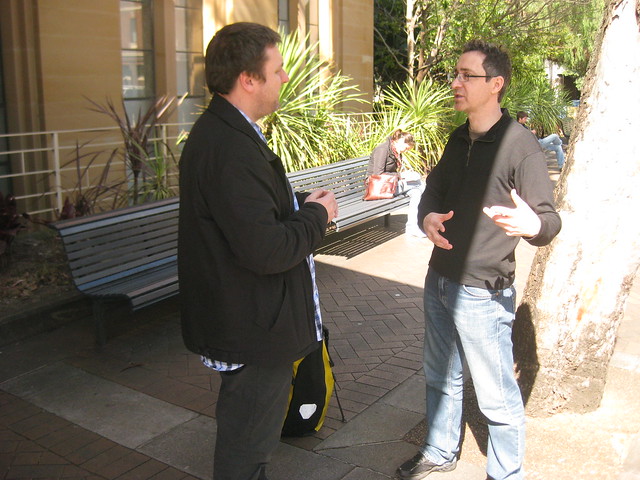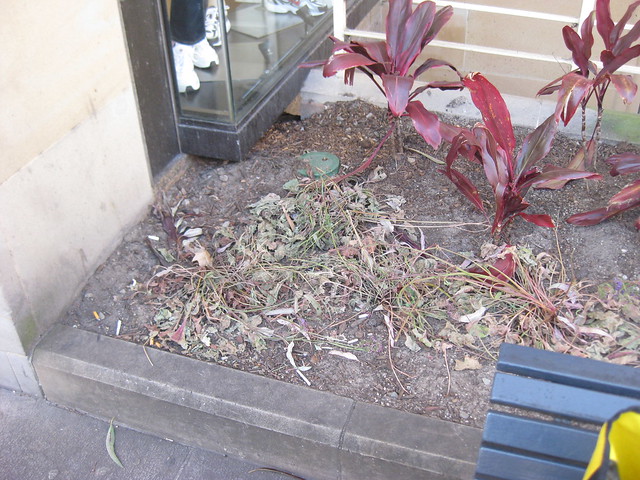In light of some of the recent discussions around the museum regarding waste processing, today I took it upon myself to invite my friend Paul, aka “Dr Worm” to consult.

Here he is, gesticulating carefully as he explains the relative merits of worms versus other sorts of composting to Glenn the curator.
.
What I’ve noticed with the organisation is that there seems a strong willingness to make small and manageable changes; it’s just that there’s not a huge amount of time sloshing around, to investigate the options and how to carry them out.
Paul and I have recently completed a permaculture design course together. One of the outcomes is that we have an instant network of very clever colleagues to call upon for such consultations.
I figured that Paul might be able to do a bit of an ad-hoc site survey to explore the possibilities for diverting organic matter from landfill, with an eye to submitting a rough proposal to the MCA – making it all a bit easier for the organisation to consider.
As Paul was checking his bag in at the front desk, I introduced him to “B” and Kate, two of the cheery visitor services officers. Paul showed them a flyer he’d printed for a large scale Bokashi bucket which he thought might be appropriate for the MCA. “B” in particular was interested, picking his brains on how Bokashi works. (Basically, its an anaerobic composting system which pickles or ferments your food scraps. These pickled scraps are then buried in the garden where they rapidly break down to form rich composty soil.)
I took Paul upstairs to the staff kitchen to show him the newish recycling bins, and to suss out the space for its potential for hosting organic waste systems. His appraisal was that our kitchen is quite small. There might be room for one of the smaller bokashi buckets on the bench, but not really for a decent worm farm – perhaps a “worm cafe” (but even that might be tricky to squeeze in).
He did like the look of the board-room though, with its million dollar views overlooking Circular Quay. I think it’d be brilliant. But I’m not sure what luck we’d have sneaking a compost system into the board room.
Paul wondered whether there might be another space – a courtyard, a balcony, a laundry, where something could be set up so that it would be easy to access and yet not in the way. Can anyone think of one?
Continuing our explorations, I took Paul in to meet Glenn, one of the MCA curators. Glenn was a bit pessimistic. One of the problems is that with a Bokashi system, you need to dig into some dirt to bury the pickled food scraps. The MCA is bordered by grass and gardens on the east and south sides, but these are under the jurisdiction of the Sydney Harbour Foreshore Authority (SHFA). Permission would have to be obtained to dig a hole and bury the waste there. (Those who are familiar with the process of negotiating with SHFA might understand how tricky this could be.)
Undaunted, Paul’s eyes glazed over as he imagined a food forest, perhaps akin to the one the Artist as Family has installed in the yard of St Michael’s in Surry Hills, filling the grassing knoll in the front of the museum. He pictured himself spading bokashi into the sandy loam, an old bathtub full of worms nearby writhing in pleasure at a new bucket of lunchscraps freshly delivered. The result of which would be a carbon-and-nitrogen enriched soil, abundantly producing and attracting visitors for miles around. Now that would be something.
Interrupting this reverie, Euan (the Chief Operating Officer) strode past; Glenn lassooed him in. We introduced Paul, and Euan quickly agreed that, yes, something would definitely be a good idea. He had to run – but as he strode off again he reminded us that there were also on-site cafes and in-house Functions to consider, as other potential sources of organic nutrient.
Before he left, Glenn I and took Paul for a lap of the building’s exterior. Personally, I wanted to see if we could find some small corner of soil we could use as our bokashi-burial zone. We did, sort of. Here, on the George Street side of the building, next to the souvenir store, is a rather neglected patch with dying plants and cigarette butts aplenty:
Could that be the beginnings of an MCA bokashi-boosted mini-garden?
While we stood there thinking (and marvelling at the sheer laziness of wanton cigarette-butt discarders), we also noticed the empty shopfront. This used to be the David Campese coffee shop, which has for some reason recently closed down. It’s now for lease, but I wonder how long it’ll take to find a new tenant. The thought of this unused space sent all three of us into paroxysms of imagination.
What if the space were temporarily set up as an inspiring, sexily-DIY, Zone of Composting Glory? Not only would this be an excellent educational opportunity for MCA staff (and of course, we could get Dr Worm in again to run empowering workshops), but it would also be a clear and visible demonstration to the outside world that a large organisation can integrate on-site waste management into its daily life. If adopted, our ingenius plan would show that a Museum of Contemporary Art could be really avant-garde – beyond the frame of the white cube!
Foaming with excitement, we all three went our separate ways, daydreaming the microbial breakdown of banana skins. As Paul says, “Waste aint rubbish – it’s Food“.


Two quick updates following from Dr Worm’s visit:
First, Glenn came up with the idea of forming an ‘environment committee’ from within the staff of the MCA, which could oversee the daily functioning of worms or bokashi – but which could also meet and discuss higher level policy stuff.
I mentioned this to Judith, who immediately responded that she would be willing to join such a committee.
Second, I bumped into Tony near the lifts on the fifth floor. He had already read the above blog entry. Tony said to me:
“You know, when I was 18, I travelled around the world, and of course I had to use a passport. However, I felt very strongly that there was no need for them. I thought all international boundaries should be open and unregulated. But you know, I’m not so sure I think that any more.”
By which, if I’m not mistaken, Tony means that some of the pie-in-the-sky ideas presented here (and in other places around this blog) are heavier on imagination than pragmatics.
With regard to pragmatics, Tony also has some things to get off his chest about what he sees as the naive views of the anonymous preparator known only as “Hank” (Hank is very critical of the resource-intensive presentation of artworks at the MCA).
Oh, and he wants me to do a POSITIVE feature on the MCA’s waste-paint processing equipment, which is, he says, an incredible environmental initiative and a first in Australia. Hopefully we’ll get onto that next week…
I’m really looking forward to Tony chiming in here on the blog with his views. But I know it’s difficult for some of the busier museum workers like him to prise time away from their other duties for this kind of thing…
Hi Lucas, am at last able to put down a few thoughts and responses to your blog entries that have featured comments, opinions, thoughts, musings and criticisms of Exhibition Services Dept here.
Yes it was a pretty full on week last week leading up to the ‘Grand Opening’ but then we always knew it would be; you have been there in the past when I have been able to cajole you into being part of the crew during a changeover time, so it was not all new to you.
I did drop the borderless world comment to you yesterday in response to your musings on the opening, deadlines and the mad rush towards completion. If only if it was about “a sense of achievement†and a “certain clarity to our otherwise murky everyday activities†as you suggest but as the museum as a whole involves a whole range of activities especially from the areas of Education and Marketing that have events and sessions (sometimes paid) that are booked often months in advance those ‘fringe benefits’ you mention are if we are lucky just that.
Now to Hank. I only know Hank generically but understand his comments and where he is coming from. Hank is a casual; he is an important part of how we do things here; he is skillful and extremely knowledgeable.
First a little background to why we build so many walls and we do and always have built a lot of walls. A quirk of this building of ours is that we have columns; they run North South in the 2 end wings of the building and East West in the central section. The approximate distance between the columns is a bit over 4 metres. Our ceilings throughout the single height spaces vary from room to room (how annoying) but are generally just over 3 metres.
All our cavities between individual Galleries are built around columns. SO if you build a wall around a visible column back to the wall the space contained will have a wall that is approximately 4m x 3m which just so happens to equate to what up until recently has been the predominate format of video playback. I am not saying this quirk of architecture has dictated either our exhibiting or collection policy but it has certainly made (with the addition of some simple walls) (3m ceilings is low for a Museum) the construction of video viewing spaces extremely straightforward.
Now the inevitable consequence of building walls is that there is some detritus when thay are pulled down. Yes I know it is a shame but inevitable. We attempt to reuse as much as possible and in the last turnaround where Jay and the boys came in to build, we constructed walls on 3 of our 4 floors in 13 different locations amounting to over 60 m of built walls and we only purchased a few new wall sheets. I thought that was pretty impressive. Everything else was recycled. But as the mathematical formula explains
Recycled = Available materials – waste we end up with some waste. It is sometimes skipped but as about 99.9 % is wood or metal there is some consolation in the fact that it will in time break down.
It would be good to have a completely neutral situation but as we are putting up exhibitions in a large Air Conditioned environment whichever way you cut it we are going to be a net user of energy and have some waste. Efforts are made and hopefully this show and your presence will further fire up the existing efforts to minimize our footprint.
Look forward to showing you our wizbang Centrifuge Paint separator next week.
And true to his word, Tony did show me the wizbang Centrifuge Paint Separator. Read all about it here.